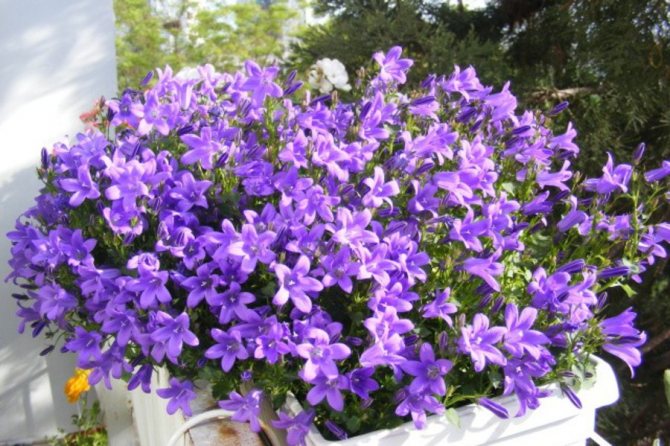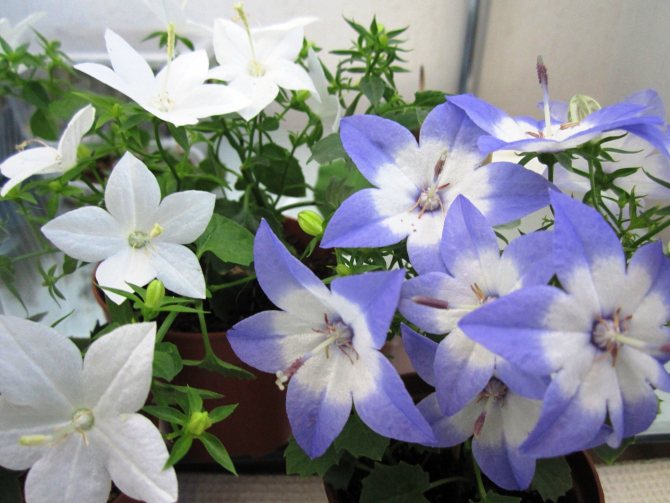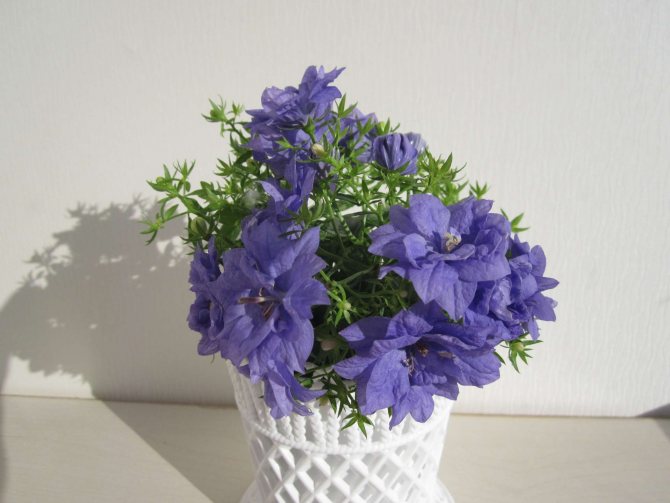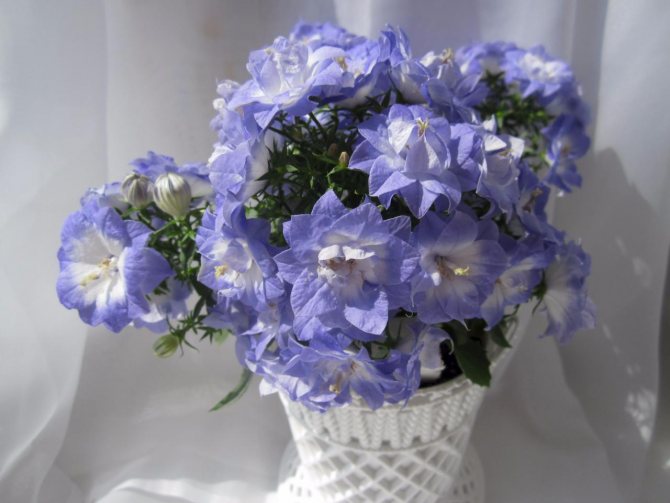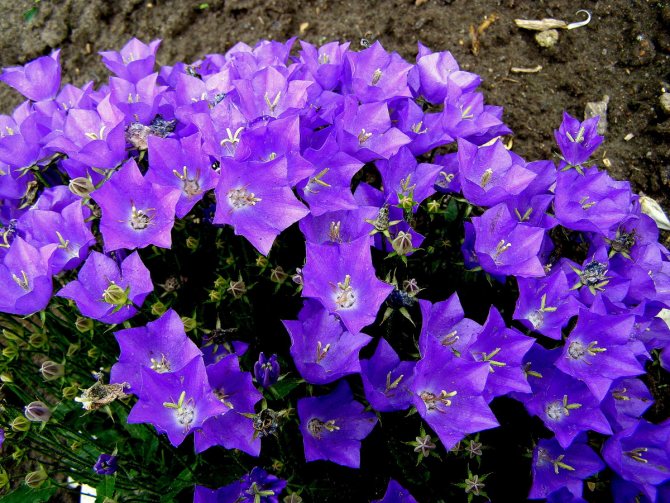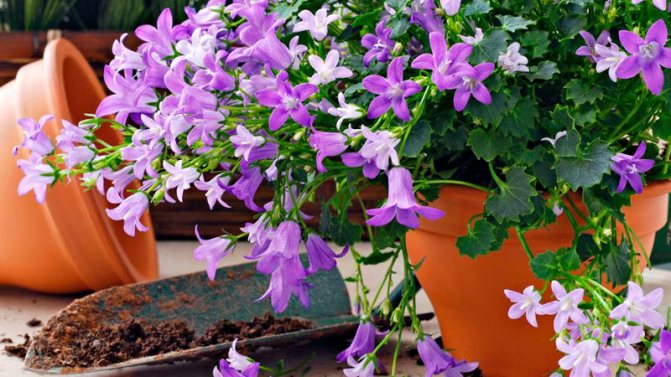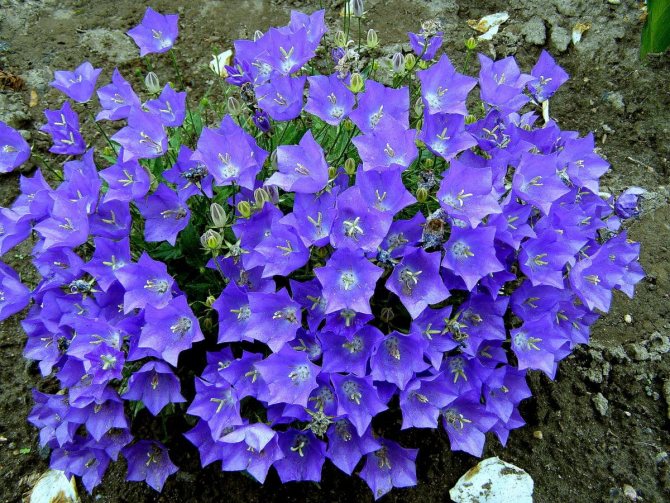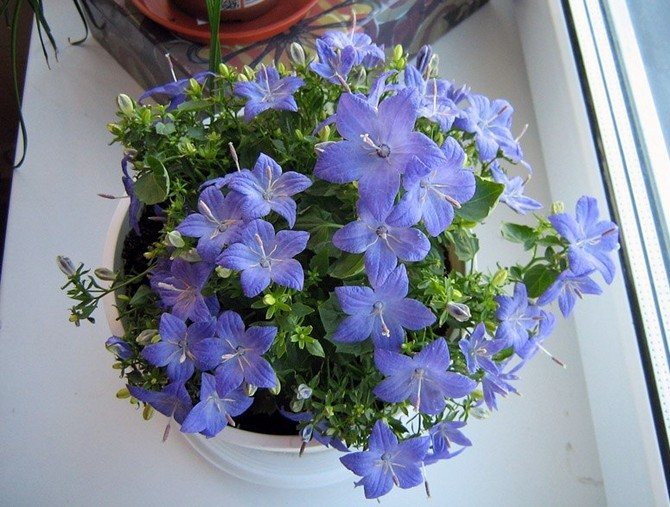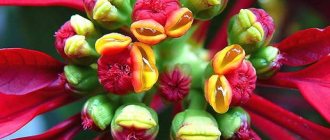Companula - growing this plant at home is a delight, because the beauty and aroma are divinely beautiful! Otherwise, this plant is called: "Bride and Groom" or "shooting stars", which was previously very common among flower growers, but recently you rarely see it on the windowsills of flower growers, perhaps due to the appearance of more exotic plants and due to the fact that such plants are becoming increasingly available easier.
Attention! Campanula does not tolerate drafts at all, so it is very important to choose a warm and sunny place.
Caring for the plant is not difficult, even a novice gardener can handle it. Among the people, the plant is better known under the name "Bridegroom and Nivesta". The groom - with white flowers and the bride with blue.
Homeland and appearance of campanula
Campanula (Campanula) is a herbaceous plant of the bellflower family, numbering more than 300 species. The homeland of Campanula is the Mediterranean and the countries of southern Europe, where it is widespread in the wild. Sunny hillsides, meadows and valleys are literally covered with caps of blue, white, pink inflorescences. Bellflower have found recognition among landscape designers and amateur flower growers. About 100 species of this plant have been cultivated and used in plant growing. In home floriculture, only one type of Campanula is used - Campanula isophylla Moretti, it is the hybrids of this species - Alba, blooming with white flowers and Mayi with blue bells, received the name "Bridegroom" and "Bride". Equivalent Campanula is a miniature ampelous plant. The length of the shoots of campanula does not exceed 25-30 cm. The leaves are cordate on long petioles, arranged alternately. The white-flowering Alba hybrid has a lighter color than the Mayi variety. There is another cultivar of Campanula isotopia - Starina Bicolour - these are delicate, blue and white bells.
Garden, vegetable garden and flower garden tips
How to feed gladioli for abundant flowering?
Watermelon in the middle lane in the open field
Why do potato leaves curl photos and their treatment
Biologists have described about 300 species of campanula, but only a few of them are grown "in captivity".
- Carpathica. Campanula carpática is a perennial herb. Its height, as well as the diameter of the bush, can reach 30 cm. The leaves of this species are basal, have an ovoid-rounded shape and are collected in a basal rosette. Flowers reach 5 cm in diameter and can be white, blue or purple. Its homeland is the slopes of the Carpathian Mountains. Its flowering period begins in summer and lasts about three months.
- Terry. A variety of equal-leaved bell, a hybrid of the Carpathian and False-leaved campanula. Florists call her Curly. A miniature lush bush grows only 13-15 cm in height. Flexible, fragile stems branch, grow densely. Leaves are densely planted, growing alternately. The leaves are small, carved, triangular in shape, pointed edges. Terry flowers, small, up to 2 cm in diameter. The color scheme is varied - snow-white, bluish, bright purple, purple flowers with an ink shade are generously strewn on one bush.We recommend reading an article about caring for a campanula plant. The peculiarity is to achieve abundant and generous flowering only by an experienced grower, these varieties react painfully to any violations of care and maintenance. The most common bred dwarf terry varieties are Blue Bali, White Bali, Blue Miracle, White Miracle. Often used in the garden, on alpine hills, among rocky compositions. In indoor conditions it grows worse, in warm weather it is imperative to take it out into the open air - a balcony, a loggia, a veranda.
- Broadleaf. Refers to a typical subspecies of perennial tall bells. In the wild, it is found in Europe, Asia Minor, Altai and the Himalayas. It grows on rocks, wastelands, forests and steppes. Stems are strong, cylindrical, angular tops, grow more than 1 m in length. Shoots are erect, glabrous. Basal leaves are large, up to 13-14 cm in length, up to 5-6 cm in width. The petioles are dense, shortened. The upper leaves are sessile, with pointed ends, of medium length - 3-4 cm. The leaves are oblong in shape, serrated at the ends, slightly pubescent on both sides. The flower itself is funnel-shaped, large, up to 6 cm in diameter, there are pale white and purple colors. Sepals are pointed. The flowers are combined into inflorescences-brushes, arranged in the form of an ear. Flowering begins in July; capsule seeds ripen at the end of August. The variety has a well-developed, branched root system. The peculiarity is a hardy look, it tolerates shady areas well. In home floriculture, it belongs to the garden species of campanula. The most popular varieties for home gardening are Alba, Makranta and Brantwood. Suitable for group planting, on mixborders and slides. Important: the root and leaves of broadleaf campanula contain inulin - a storage carbohydrate, a natural prebiotic that has a beneficial effect on the intestinal microflora.
- Cirillo. One of the rare breeding varieties of brittle bell (groom). Homeland - Sicily. The variety is named after the botanist D. Cirillo. This variety is called the Blue Crystal. The flowers are simple in shape, the main color is blue, the center of the flower is slightly darkened. Shoots are long, ampelous, slightly pubescent, up to 25 - 30 cm long. The leaves are small, rounded, bright green, growing alternately. The peculiarity of the subspecies is that it grows in lush cascading rosettes, the antennae are elongated. Blooms in late June. Flowering is long, up to 4 - 5 months. Mainly grown as an indoor flower.
- In indoor conditions, as a rule, only 1 species is cultivated - the campanula is equally leaved, or this plant is also called "the bride and groom". This species is a perennial, the stems of which are about 0.3 m long, they can be creeping or hanging. Alternately greenish leaf plates have long petioles and a serrated edge; their length can vary from 30 to 70 mm. Terminal corymbose panicles consist of flowers reaching 20–40 mm in diameter. The color of the flowers can be pinkish, lilac, white, blue or lilac. Most often, a couple of varieties of campanula with a contrasting color are planted in one container, it is because of this that this variety is called "bride and groom".
- Blauranka. Campanula Blauranke is a variety of Campanula Pozharsky. It has a rather large appearance, it grows up to 20 cm in height. The flowers are light blue. The Blauranka variety is excellent for growing not only indoors, but also outdoors.
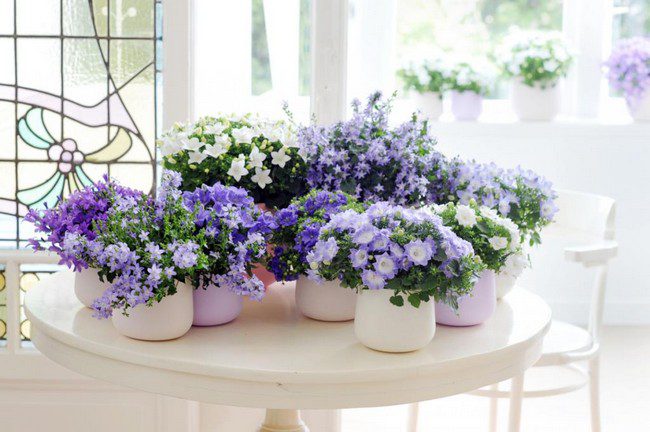
Breeding
Seed planting
- Seeds should be planted in the ground in the spring. Pre-soak them in a weak solution of potassium permanganate or "Kornevin".
- Pour soil into a plastic cup, moisten, sprinkle dry soil on top, sow seeds and sprinkle with water. Cover with plastic wrap and place in a warm, well-lit place.
- With the appearance of 3-4 leaves, transplant into flowerpots.
By dividing the bush
The safest and easiest way to propagate a plant. In the spring, when the campanula begins to grow actively, remove the bush from the pot, carefully cut the earthen lump in half and plant the halves in different pots. The rest of the care is as usual.
Propagation by cuttings
- Use a sharp, sanitized blade to cut off shoots with a few healthy leaves.
- Put them in a weak solution of potassium permanganate for 10-12 hours.
- With the appearance of the roots, transfer it to a container with clean water for a couple of hours, and then plant it in a container with a substrate (a mixture of peat and river sand). Depth - no more than 3 cm. Cover the container with cling film, creating the effect of a greenhouse, spray and air the seedlings daily.
- Once the root system is strong, plant the cuttings in permanent pots.


Location and lighting for growing campanula
Campanula likes diffused bright light. It is better to protect the flower from the sun's rays. It will feel great if placed on a west or east window. When placed in the southern part of the house, the campanula must be shaded. If you notice that the leaves of the campanula are curling and withering, then most likely this is due to excess sun. If it receives less light, the shoots become elongated, the leaves are at a distance more than usual, and the flower loses its former appearance. When there is no way out, and the home campanula must be placed on the north window, then it is imperative to organize additional lighting for at least two hours a day.
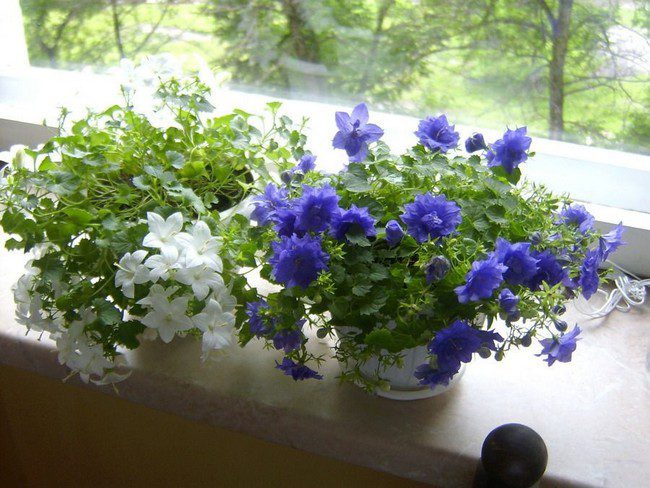

Annual and perennial varieties
The indoor form of this plant has an interesting feature - being a herbaceous perennial, Campanula degenerates rather quickly, requiring constant transplantation and renewal. Therefore, it is most often grown as an annual. For growing for many years, it is necessary to provide the plant with campanula care at home such as is recommended by experienced growers. The cool temperature during the wintering period plays an especially important role.
Since not all varieties are perennial, this must be clarified when purchasing. Then you can grow a flower with the expectation of many years, stimulating new flowering with proper care.
There are several types of campanula and several hybrids. For example, as a result of crossing a Carpathian and a spoon-leaved bell, a terry campanula was obtained, Care at home for it is carried out in the same way as for an equal-leaved campanula.
Watering the campanula
- Bred in areas of southern Europe, the plant can in principle tolerate drought.
- But still it is necessary to water the campanula at least once a week, especially during the flowering period.
- This flower may not withstand excessive moisture, therefore it is important to ensure that water does not accumulate on the pan of the pot.
- As for spraying a plant, you should also not "be zealous" when flowers are tied on it, it is better to cancel spraying altogether.


Garden, vegetable garden and flower garden tips
Waning moon in August 2020 when from what date to what date
Moon phases in August 2020 by day for gardeners and truck farmers
The growing moon in August 2020 when from what date
Campanula care video
It is believed that campanula radiates positive energy, filling the house with tranquility. It doesn't matter if it was presented to you for a wedding or came to you in some other way, the plant will fill the house with an atmosphere of warmth and serenity.
Plant the "Bridegroom" and "Bride" in one pot, their branches will intertwine and you will get a fabulous plant of extraordinary beauty and grace.
Follow the simple rules: timely watering, good lighting and the result will not keep you waiting long, from year to year the bells will delight the eye with amicable and abundant flowering.
Love your flowers, and in return they will give you a lot of positive emotions.
You can also share your Campanula Care Secrets. If you have any questions - ask them in the comments below, we will be happy to answer them.
What feeding does Campanula need?
She needs regular feeding during the period of active growth and flowering. Once every 10-20 days, it is fed with fertilizers for flowering indoor plants. It is good when they contain iron, boron, zinc, magnesium. Helpful advice. It is recommended to reduce the rate by half of that specified by the manufacturer. Once a month, the plant is fertilized after flowering. Stop feeding during the rest period.
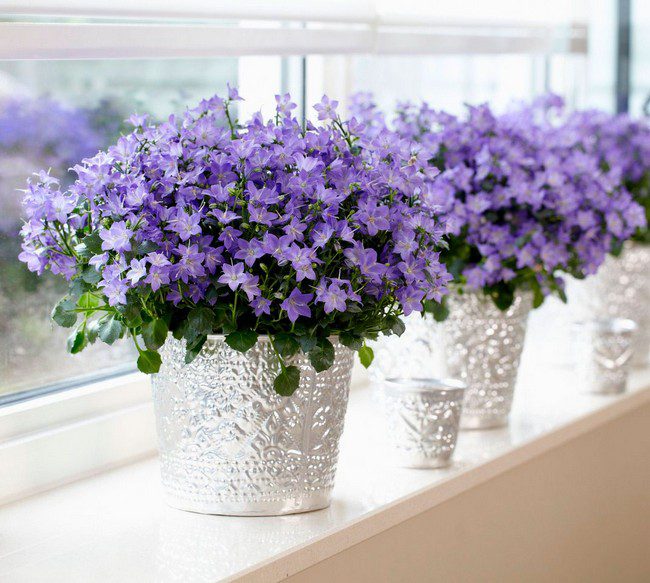

Garden, vegetable garden and flower garden tips
Kupena: planting and care in the open field
How to drive ants out of the garden
When can you plant strawberries in the summer with a mustache?
Home care
Campanula grows naturally in temperate climates. Therefore, there are no particular difficulties in caring for her. Most of all, the plant is demanding on lighting.
Location and lighting
The best place for a flower in the house is the east and west windows. On the south side, it will need to be shaded. When the weather is warm, the flowerpot can be taken outside, but not into a draft. The plant must be protected from direct sun. But the lack of lighting is also bad for the culture. Its stems are strongly elongated, the number of flowers becomes less.
Note! The bells tend to the sun, and if the flowerpot is in one position, then the campanula grows in one direction. So that the bush is not skewed, but develops evenly, once a week it must be turned in one direction. But you cannot make sharp turns by 180 °, otherwise the plant will shed its leaves. It is better to immediately choose a place where the light will fall evenly from all sides.
Choosing a flowerpot
The flower container is wide, but shallow. With each transplant, the volume of the pot must be increased by several centimeters. The root system quickly fills in new space. In order for the campanula to bloom profusely, the pot must be a little tight.
Priming
Light, nutritious soil is suitable for the plant. It must be moisture and breathable. You can purchase a universal substrate for flowering crops, or prepare it yourself: mix peat and leafy soil (1: 1). Also, universal soil can be mixed with peat, humus and river sand in equal parts to make it looser.
Planting and transplanting
Campanula is rarely transplanted. Its decorative appearance lasts no more than 2-3 years. Further, the stems become more bare, the flowering is not so lush. Therefore, it is better to breed young plants from cuttings or seeds.
The need for a transplant arises when the roots begin to look out of the pot or the flower is sick. It is also imperative to transplant a flower purchased in a store within 2-3 days. Remove all flowers and buds, cut the stems 1/3. It is better to transplant in early spring or mid-autumn.
Transplant algorithm:
- Fill the container ¼ with drain. Sprinkle it with fresh soil about halfway.
- Water the campanula abundantly so that it can be easily removed from the old pot.
- Carefully remove the plant, being careful not to damage the earthen lump.
- Cut the roots that have fallen at the bottom by a few millimeters with a clean knife.
- Place the bush in a new pot. Top up the soil, compact it slightly, water it.
- Place the flowerpot in a shaded place at a temperature of + 18–20 ° С.
- When the shoots start to grow, return the flower to its permanent place.
Visual video - instructions for transplanting campanula:
Temperature and humidity
Campanula can tolerate some temperature fluctuations. In the spring-summer period, it will be more comfortable for her at + 20-25 ° С. In winter, move the pot to a cooler room with a temperature of + 12-15 ° C.
The culture is not particularly demanding for air humidity. But in hot weather, as well as in winter, when the heating is on, it is recommended to spray it. This procedure is necessary to ensure the density of the foliage.
Watering
Campanula is a moisture-loving flower. But she does not tolerate stagnant water. The irrigation regime is adjusted depending on the phase of the plant's life. During the growing season (from spring to autumn), you can water it daily with soft, settled water. The soil must always be moist. After the end of flowering, the shoots stop growing. Watering is reduced to 2 times a week. In winter, the culture rests, 1-2 waterings per month are enough for it. After watering, drain excess liquid from the pan to avoid root rot.
Top dressing and fertilizers
When the campanula is actively growing, it needs feeding every 10-12 days. During this period, a lot of energy is spent on the formation of inflorescences.
You can take any fertilizer for flowering crops:
- Ideal;
- Agricola;
- Rainbow;
- Fantasy.
Prepare the solution according to the instructions. Fertilizer can be introduced only after watering to avoid root burns.
Flowering and resting period
Campanula begins to bloom in mid-spring - early summer. With good care, this period can last up to 6 months. Flowers can be of different colors, depending on the variety. They have 5 wide-spread petals, shaped like a bell. Corollas are collected in racemose inflorescences. There are so many of them on the bush that they form a flowering carpet covering the leaves.
Withering and dry flowers must be removed. If the campanula does not bloom well, the reason may be a lack of lighting, fresh air, and lack of fertilizing. Plants that are more than 3 years old also begin to bloom poorly. Therefore, it is better to replace aging specimens with new ones.
In winter, the flower needs peace. He is transferred to a cool, bright place. Within 2-3 months, the number of watering is minimized, feeding is stopped. All shoots before the dormant period must be cut to 10-12 cm.
Pruning
To preserve the decorativeness and lush flowering of the campanule, pruning is carried out. After the end of flowering, remove dry inflorescences, cut off damaged shoots. Serious pruning is required in the spring upon awakening. Not only areas that have died out during the winter are removed, but all the tops of the shoots are squeezed. After 3-4 weeks, the young shoots that have appeared are pinched. Such a procedure will not only give the bush a decorative look, but also stimulate abundant flowering.
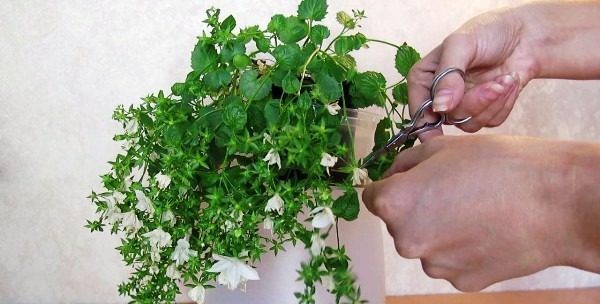

Diseases and pests of campanula
Ailments little affect the adult sample of campanula. Factors that undermine the health of a plant are often improper care, lack of fertilizers. For example, excessive moisture and insufficient illumination increase the risk of developing fungal diseases: powdery mildew, rust, etc. If you identified these infections from the photo, immediately spray the soil with foundation or products containing copper, potassium permanganate.
Of the pests of Campanula, ants, aphids and slugs have chosen. In this case, use special insecticides.
In conclusion, it should be added that this plant will be an excellent decoration for any garden or balcony. It, even with minimal care, will delight those around with its magical beauty all long summer.
Description of the plant
Garden campanula is a herbaceous plant up to 50 cm high with long, thin shoots. The stems can be erect or creeping. It is no coincidence that the flower is grown as an ampelous plant. Campanula leaves are small, arranged alternately and have a slightly elongated or heart-shaped shape. There are small notches along the edge of the sheet. The surface of the leaf plate is painted in a rich dark green or bright green color.During the growing season, the shoots densely cover the soil and create a kind of pillow 20 cm high.
The flowering period of Campanula garden lasts from July to September. Flowers form in the leaf axils or at the top of the stem. They can be either single or collected in inflorescences resembling panicles or balls in shape. The diameter of the flower depends on the variety. They resemble bells in shape and consist of five petals. The color of the corolla is varied. The petals can be white, pale blue, deep blue or purple. White flowers are usually called “bride, and blue or purple flowers are called“ groom ”.
How to propagate a bell
Again, Campanula is not a perennial. The average life span of a plant is two years, sometimes a little more. If you do not want to say goodbye to the "shooting star" a couple of years after purchase, multiply it. You have several ways to choose from:
When you carry out spring pruning, pinch off the heel cut from the mother plant. That is, you need to tear off the young shoot at the very bottom so that part of the skin and core of the mother stem remains on it. And at the bottom of the cutting there should be two or three leaves. Follow these five steps to root Campanula with cuttings.
By dividing the bush
Campanula can be propagated in this way directly during plant transplantation. It is better to do this in spring or at the very beginning of summer. Here's a seven step guide.
- Remove the bush along with the clump of old earth.
- Divide it into several pieces - just cut the roots with a sharp knife.
- Delenders should not be too small.
- Place each piece in your pot. Don't forget to put a drain on the bottom.
- Deepen the plant 2-3 cm into the ground.
- Top up with the required amount of soil and tamp lightly.
- Water the plant.


Propagation of campanula by seeds is carried out in the spring, at the beginning of March. This is if you already have a mother plant. Or buy seeds from the store. So, in the fall, when the bell has faded, look for miniature boxes on the stems - there are seeds. But do not rip off the box - let it remain on the plant, it will burst itself when the seeds "ripen". Campanula seeds are very small, more likely to resemble dust, they can even be blown off by carelessness. Then follow the six-step instructions.
- Carefully open the "house".
- Prepare a clean container and suitable soil.
- Spread the seeds as evenly as possible on the ground.
- It is not necessary to deepen the seeds. Just sprinkle them with a little soil or sand.
- Spray the soil with a spray bottle.
- Cover the seedlings with plastic wrap and air them daily.
Usually indoor flowers infect two pests: spider mites and scale insects. If you notice a parasite on at least one plant, there is a high risk of infection for all "neighbors". Isolate the diseased plant immediately and immediately start fighting the "enemy".
Spider mite
If you notice "cobwebs" between the base of the leaves and the stem, this is a reason to think. Inspect the inside of the leaves, if you notice something that looks like stuck earth - poke the "dirty" place with a thin needle or toothpick. It turned out to be not dirt at all, but scanty brown bugs that scattered about? This is a spider mite. First, break off all the infected leaves, so you will already get rid of a large number of pests. And what to do next is described in the table.
Read also: Rules for digging land, when and how to dig up land in the country
Transplant: selection of pot and soil
Some experienced florists recommend transplant campanula
only when she is already very cramped in the pot - the flower does not like frequent transplants. But still, you need to transplant the campanula into a larger pot - this will ensure comfortable and active growth.
The soil should be used loose, you can make a mixture or buy ready-made, it consists of sand, humus, peat and leafy soil.
The transplant consists of the following stages:
- Holes must be made in the new pot if they are missing. Pour a layer of drainage - this can be expanded clay approximately 2-3 cm, depending on the size of the pot.
- Cover the expanded clay with earth and carefully, without damaging the roots of the plant, transplant it, fill up the missing part of the earth.
"Home" types of bells
Usually, on our windowsills and balconies, the subspecies of the campanula is flaunting: "Alba" (Alba) and "Maya" (Maya). "Alba" has white inflorescences, for which the people called her "the bride". "Maya" is blue, she is called "the groom". And there are also two-colored plants - "Bicolor", the popular name "lover". But in fact, sometimes there are other varieties of campanula, for example: "Karpatskaya", "Makhrovaya", "Blauranka". The table shows the distinctive features of the most common plant varieties.
Read also: How to properly dry mint for the winter?
Table - Varieties of "domesticated" campanula


